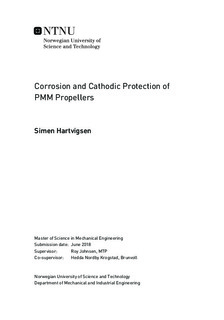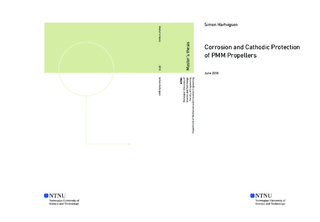| dc.description.abstract | This thesis will examine the effect of water flow on cathodic protection (CP) of AISI 316L Stainless Steel (SS) and Nickel-Aluminium bronze (NAB). It will also examine the effect water flow has on the galvanic current of these metals. The SS and NAB are fitted to a structure inside a geometrically confined gap, and CP of these metals will be investigated with special regard to the potential drop through the confined gap. There will be conducted three experimental tests; CP without flow, CP with flow and galvanic couple with flow. A multiphysics modeling program called COMSOL will then be used to simulate the same scenarios using polarization curves collected after each test as boundary conditions. The first two tests will have a special regard to whether CP will be able to protect the metals through the gap. The third test will examine the effect of water flow on galvanic corrosion. The objective is to test whether or not CP can protect the metal surfaces through the confined gap with and without water flow. An aluminium sacrificial anode was used for the first experiment, and was placed outside of the test cell. The corrosion potential of the aluminium anode was -1,064V vs. Ag/AgCl, and the potential of the electrode surface in the middle of the test cell, which is furthest from the anode, was -0,96V vs. Ag/AgCl. This is a potential drop of 104mV, and the potential inside the test cell is sufficient to cathodically protect the metal surfaces. For the second test, a potentiostat was used and applied a potential of -1,050V vs. Ag/AgCl. The potential of the sample furthest away from the anode was measured at -0,42V vs. Ag/AgCl. According to ISO 12473:2017, this potential is not sufficient enough to cathodically protect the surfaces inside the test cell. A COMSOL model was used with polarization curves recorded after each of these tests as boundary conditions. This model showed that the largest potential drop occurred through the first segment, which had the smallest cross-sectional area for the seawater to pass through, which also has the highest fluid resistance. The model also showed similar current densities as was measured during testing, and similar electrode potentials inside the test cell. The third test was a galvanic couple between SS and NAB. Test 3 shows the behaviour of the galvanic couple, and measures the current production from the less noble metal (NAB), and the current consumption of the noble metal (SS). Over time, corrosion products developed on the surface. These corrosion products have not been examined but compared to similar results in literature. The assumption is that with higher water speeds these deposits will be removed, and the effect of galvanic corrosion will decrease. | en |

